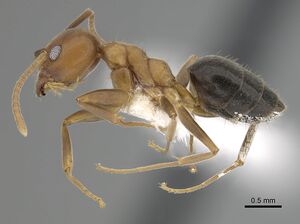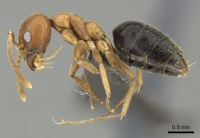Technomyrmex hostilis
| Technomyrmex hostilis | |
|---|---|

| |
| Scientific classification | |
| Kingdom: | Animalia |
| Phylum: | Arthropoda |
| Class: | Insecta |
| Order: | Hymenoptera |
| Family: | Formicidae |
| Subfamily: | Dolichoderinae |
| Genus: | Technomyrmex |
| Species: | T. hostilis |
| Binomial name | |
| Technomyrmex hostilis Bolton, 2007 | |
Specimens collected by Ward carry the data “ground forager, rainforest edge”.
Identification
Bolton (2007) - A member of the T. semiruber complex in the Technomyrmex albipes group. In the Afrotropical fauna the three species Technomyrmex menozzii, Technomyrmex hostilis and Technomyrmex semiruber form a complex of closely related forms within the albipes group. However, these three together are larger (combined HW range of 0.76 - 0.89) than other species of the group, which show a combined HW range of 0.46 - 0.70 for the species Technomyrmex albipes, Technomyrmex difficilis Technomyrmex moerens, Technomyrmex nigriventris, Technomyrmex pallipes, Technomyrmex vapidus, Technomyrmex vitiensis. Also in the three species the propodeal dorsum rounds broadly and evenly into the declivity, rather than the two surfaces meeting in a blunted or sharp angle, as is characteristic of the other seven species just mentioned.
T. semiruber is much more densely setose than hostilis and menozzii and has projecting setae on the scapes and tibiae, features that are absent from the other two. T. hostilis is a strikingly bicoloured species with orange head, mesosoma and legs, and a very strongly contrasting black gaster. In contrast menozzii has the head, mesosoma and gaster a more or less uniform blackish brown. In addition, hostilis has no setae on the posterior margin of the head but has 4 5 pairs of setae on the pronotum and the same number on the mesonotum, whereas menozzii has setae present on the posterior cephalic margin but has far fewer on the mesosoma, with only - 2 pronotal pairs and a single mesonotal pair. Both species are known from only sparse material, so some variation in these setal characters may be detected when more material is found.
Keys including this Species
Distribution
Latitudinal Distribution Pattern
Latitudinal Range: -5.732599° to -5.94905°.
| North Temperate |
North Subtropical |
Tropical | South Subtropical |
South Temperate |
- Source: AntMaps
Distribution based on Regional Taxon Lists
Afrotropical Region: United Republic of Tanzania.
Distribution based on AntMaps
Distribution based on AntWeb specimens
Check data from AntWeb
Countries Occupied
| Number of countries occupied by this species based on AntWiki Regional Taxon Lists. In general, fewer countries occupied indicates a narrower range, while more countries indicates a more widespread species. |

|
Estimated Abundance
| Relative abundance based on number of AntMaps records per species (this species within the purple bar). Fewer records (to the left) indicates a less abundant/encountered species while more records (to the right) indicates more abundant/encountered species. |

|
Biology
Castes
Worker
Images from AntWeb
   
| |
| Worker. Specimen code casent0249787. Photographer Shannon Hartman, uploaded by California Academy of Sciences. | Owned by PSWC, Philip S. Ward Collection. |
   
| |
| Holotype of Technomyrmex hostilis. Worker. Specimen code casent0903058. Photographer Z. Lieberman, uploaded by California Academy of Sciences. | Owned by NHMUK, London, UK. |
Nomenclature
The following information is derived from Barry Bolton's Online Catalogue of the Ants of the World.
- hostilis. Technomyrmex hostilis Bolton, 2007a: 22, figs. 9, 37 (w.) TANZANIA.
Unless otherwise noted the text for the remainder of this section is reported from the publication that includes the original description.
Description
Worker
Holotype. TL 3.5, HL 0.90, HW 0.86, SL 0.84, PW 0.56, WL 1.18. Indices: CI 96, SI 98, 01 23, EPI 60, DTI 130.
Frontal carina with 2 setae: in profile the first at the torulus, the second at about the level of the anterior margin of the eye. No seta is present at the level of the posterior margin of the eye. Behind the level of the posterior margin of the eye the dorsum has 2 pairs of setae before the posterior margin, but there are none on the posterior margin itself. All setae on the dorsal head are shorter than the maximum diameter of the eye. Anterior clypeal margin almost transverse, without trace of a median notch or marked concavity. Posterior margin of head shallowly concave medially. Outer margin of eye does not break outline of side in full-face view. Number of setal pairs on mesosoma: pronotum 4 - 5; mesonotum 4 - 5, at least 2 pairs anteriorly on the sclerite and 2 pairs where the surface curves down towards the metanotal groove; propodeal dorsum 0; lateral margin of propodeal declivity 2 - 3. Propodeum in profile with a shallowly convex dorsum that rounds broadly and evenly into the declivity. Gastral tergites 1 – 4 each with short setae that are distinctly shorter than the maximum diameter of the eye. Head, mesosoma and all leg segments orange; middle and hind tarsi the same colour as the tibiae and femora. Gaster black, strongly contrasting with the head and mesosoma.
Paratype. TL 3.6, HL 0.92, HW 0.89, SL 0.86, PW 0.57, WL 1.20. Indices: CI 97, SI 97, or 24, EPI 59, DTI 135. As holotype.
Type Material
Holotype worker (upper of two on pin), Tanzania Tanganyika on label): Amani, xii.1951, B. M. 1952-73, (N. L. H. Krauss) (The Natural History Museum). Paratype. 1 worker (lower of two on pin) with same data (BMNH).
References
- Bolton, B. 2007b. Taxonomy of the dolichoderine ant genus Technomyrmex Mayr (Hymenoptera: Formicidae) based on the worker caste. Contributions of the American Entomological Institute. 35(1): 1-149.

